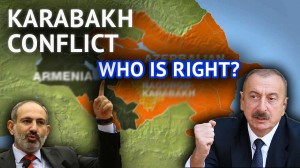 A new war began between Armenia and Azerbaijan on September 27 in the Nagorno-Karabakh region of Azerbaijan. This clash became the most serious one since the Four-Day War in 2016, and it erupted with the Armenian attacks towards military and civilian targets.
A new war began between Armenia and Azerbaijan on September 27 in the Nagorno-Karabakh region of Azerbaijan. This clash became the most serious one since the Four-Day War in 2016, and it erupted with the Armenian attacks towards military and civilian targets.
The Nagorno Karabakh conflict between Azerbaijan and Armenia started in 1988 with the territorial claims of Armenians over the internationally recognized land of Azerbaijan. Until the year 1994, when the ceasefire treaty signed, Armenian troops occupied 20% of Azerbaijani territories along with the Nagorno-Karabakh region and seven adjacent districts.
After the recent clash, Armenia and Azerbaijan declared martial law with the announcement of total and partial mobilization, respectively. Moreover, Turkey strongly condemned the Armenian attack and called it a violation of international law. Russia, a traditional ally of Armenia, only emphasized the importance of regional stabilization. Kremlin spokesman Dmitry Peskov said, “We believe that the hostilities should be immediately ended.”
Currently, the Azerbaijani counter-offensive operation continues in Jabrayil and Fizuli regions that obtain geostrategic importance. Furthermore, both sides periodically announce the military damages.
The regional tension was growing in recent years with the military drills of both sides. The line of contact became a scene of countless incidents with the death of tens of troops. This protracted conflict stands as a unique example amidst modern conflict cases. Azerbaijani President Ilham Aliyev said, “I am confident that our successful counter-offensive operation will put an end to the occupation, to the injustice, to the 30-year-long occupation.” His speech has a significant meaning to understand the course of this conflict issue.
Nagorno-Karabakh region had become an autonomous region of Azerbaijan during the Soviet Union period. After the end of the Cold War, separatist Armenians declared independence and started fighting against Azerbaijan. The war resulted in 30.000 deaths, one million people’s displacement, and Armenian control over the Nagorno-Karabakh as well as additional territories. Therefore, 20 percent of the Azerbaijani territories occupied by Armenians. Although the ceasefire agreement signed in 1994, a final peace settlement didn’t become real. Additionally, a separatist regime in the Nagorno-Karabakh region attempted to take a role as a de-facto political entity, but the international community doesn’t recognize it.
OSCE – Organization for Security and Cooperation in Europe formed the Minsk Group to utilize mediation instruments for the accomplishment of negotiations between the parties under the co-chairmanship of the US, France, and Russia. The group put a long-standing effort for three decades but could not become successful in preventing ceasefire violations and failed to design conditions for a peace settlement. The insufficient role of the mediators generated new clashes and an uncontrollable arms race in the region. Recently, Azerbaijan shared concerns about the increasing role of Russia in weapon supplies to Armenia, but Moscow didn’t give any satisfactory response.
Armenia has suffered economic hardships of the occupation for three decades, and always expected for Russian supports. The closed borders with Turkey and Azerbaijan excluded this country from all of the beneficial regional economy and energy projects. Accordingly, Armenia never accepted the offers of Azerbaijan that guaranteed even higher autonomy to the Nagorno-Karabakh and the security of all Armenians living there. This situation made Russia the only dominant player in Armenia, and thus, created a second Kaliningrad in the South Caucasus. Still, the country faces problems with population loss, economic depression, and militarization.
Armenian Prime Minister Nikol Pashinyan came to power after a revolution in 2018, and all of the Western countries hoped about the future of Armenia. Unfortunately, Pashinyan also followed the footsteps of the previous Armenian leaders who were warmongers and made Armenia one of the poorest ones in the post-Soviet geography. In that time, Pashinyan had a great chance to support the negotiation process to realize a peace settlement with Azerbaijan that promised to provide economic assistance after the resolution of the Nagorno-Karabakh problem. But he tried to become a hero after a destructive war.
Mehmet Fatih Oztarsu

 Ekim 19th, 2020
Ekim 19th, 2020  oztarsu
oztarsu  Posted in
Posted in  Tags:
Tags: 
